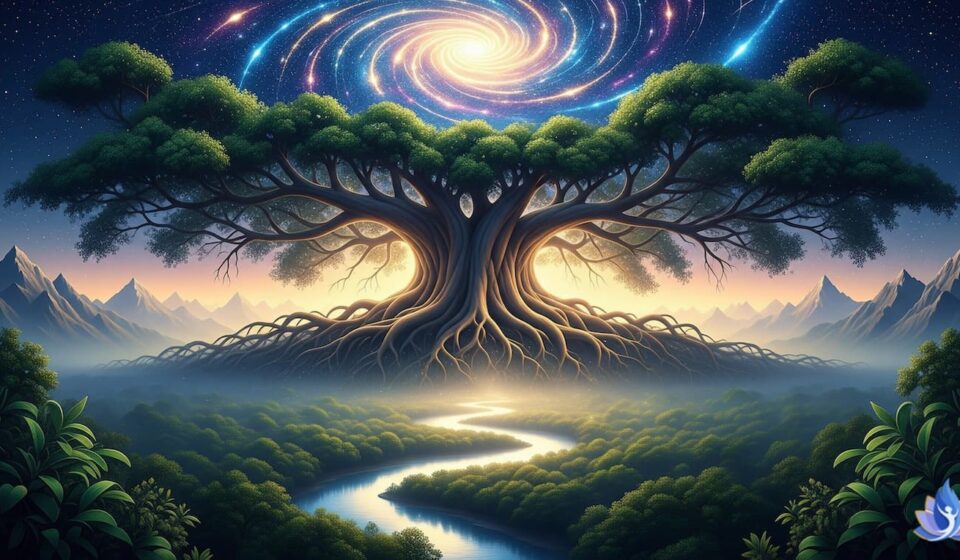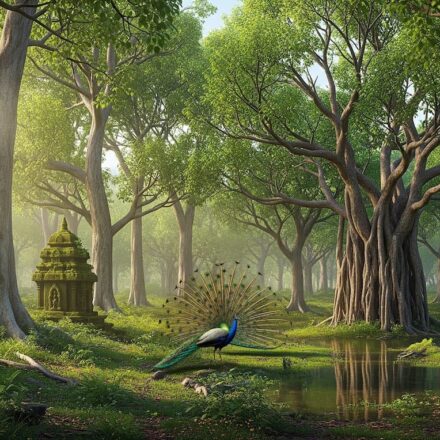
The Cosmic Tree: Unlocking Environmental Secrets from the Upanishads
In our quest to solve the environmental crisis, we look to data, technology, and policy. We measure carbon, analyze ecosystems, and debate sustainability models. But what if the most profound environmental secret isn’t hidden in a scientific report, but in an ancient spiritual metaphor? The Upanishads, the mystical heart of Hindu philosophy, present a radical vision of the cosmos that turns our entire worldview upside down—literally.
They speak of the Ashvattha, an eternal, inverted tree. This is the Cosmic Tree, a powerful symbol whose roots grow not in the earth, but in the heavens, in the ultimate reality of Brahman. Its branches and leaves spread downward, manifesting as the entire universe we experience. This isn’t just a poetic image; it’s a revolutionary ecological philosophy that holds the key to healing our relationship with the planet.
The Roots Above: A Universe Born from the Sacred
The Katha Upanishad and the Bhagavad Gita both describe this eternal Ashvattha tree. By placing its roots “above,” in the divine source, this metaphor teaches a profound lesson: the material world is not a random accident or a resource to be exploited. It is a direct, living expression of a sacred, conscious reality. Everything we see—every forest, river, mountain, and creature—is a branch growing from this single, divine root.
This perspective fundamentally challenges the modern, materialistic worldview that sees nature as separate from us and devoid of spirit. The Cosmic Tree teaches that there is no separation. The universe is not a machine; it is a living, breathing organism, and its source is sacred.
“All This is Brahman”: The Interconnectedness of All Life
The Cosmic Tree is a visual representation of one of the most powerful statements in the Upanishads: Sarvam khalvidam brahma—”All this is indeed Brahman.” If the entire universe is a single tree growing from one root, then every part of it is intrinsically connected to every other part. The leaves are not separate from the branches, the branches are not separate from the trunk, and the trunk is not separate from the root.
This vision of unity is the ultimate foundation for an ecological ethic. It implies that to harm any part of nature is to harm the whole, and ultimately, to harm ourselves. Polluting a river is not just an environmental issue; it is a spiritual transgression, a desecration of a part of the divine body. This deep sense of interconnectedness fosters a natural reverence and a powerful sense of responsibility for the well-being of the entire web of life. You can learn more about this concept by exploring the symbolism of the Ashvattha tree.
The World as a Sacred Forest
If the cosmos is a single tree, then our world is a sacred forest. This worldview inspired ancient practices that are now recognized as highly effective forms of conservation. The idea that divinity dwells in nature led to the creation of
tapovanas, or sacred groves—areas of forest dedicated to a deity and left completely untouched. These groves were not just acts of piety; they were sophisticated ecological strategies that preserved biodiversity and protected vital ecosystems, acting as natural sanctuaries.
This practice demonstrates a powerful truth: when we see nature as sacred, its protection becomes an innate part of our culture and our duty, or Dharma. It moves beyond regulation and becomes an act of devotion.
Trees as Teachers of Selfless Service
The Upanishadic vision sees trees not just as sacred objects, but as living examples of Dharma in action. A tree’s entire existence is one of selfless service. It provides shade, fruit, shelter, and purifies the air, asking for nothing in return. The Puranas capture this spirit in the saying
dasa putra samo druma—”one tree is equal to ten sons,” highlighting the immense value a tree provides to a community.
The Cosmic Tree reminds us that we are part of this grand, interconnected system of giving and receiving. It calls us to live with the same generosity and sense of duty, recognizing that our well-being is inseparable from the health of the whole. This is a timeless lesson that is more urgent now than ever, as we face the consequences of a worldview that has forgotten the sacredness of our world, a challenge that global initiatives like the UN’s focus on biodiversity are now trying to address.
Conclusion: Reconnecting with Our Roots
The Cosmic Tree of the Upanishads is more than a myth. It is a powerful ecological secret, a call to shift our consciousness from a human-centered perspective to a life-centered one. It teaches us that to heal our planet, we must remember where our true roots lie—not in the soil beneath our feet, but in the sacred, unified reality from which all life unfolds.
If this article offered you a new perspective, please share it with someone who might find it valuable. Spreading this ancient wisdom is a step toward a more conscious world. For more insights that connect timeless knowledge with modern life, follow us on our social media channels and continue exploring at aninspiredsoul.com.










